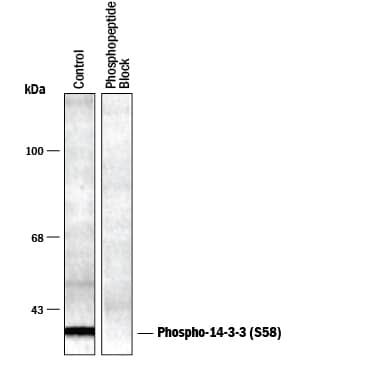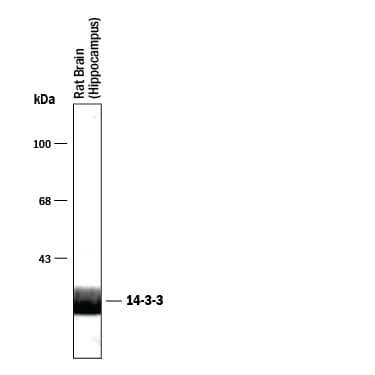Phospho-14‑3‑3 (S58) Antibody Summary
Customers also Viewed
Applications
Please Note: Optimal dilutions should be determined by each laboratory for each application. General Protocols are available in the Technical Information section on our website.
Scientific Data
 View Larger
View Larger
Detection of Phospho-14-3-3 (S58) by Western Blot. Western blot of rat brainstem lysate showing specific immunolabeling of the approximately 29 kDa 14-3-3 protein phosphorylated at S58 (Control). The immunolabeling is blocked by the phosphopeptide used as the antigen (Phosphopeptide Block) but not by the corresponding dephosphopeptide (not shown).
Preparation and Storage
Background: 14-3-3
14-3-3 is a general name given to seven ubiquitously expressed, 28 kDa proteins that are the products of related, but separate genes. They are considered isoforms and are named eta ( eta ), gamma ( gamma ), delta/zeta (δ/ zeta ), alpha/beta ( alpha / beta ), theta/tau ( theta / tau ), sigma ( sigma ), and epsilon ( epsilon ). The first molecule was named for its 14th DEAE elution fraction and 3.3 migration pattern on gel electrophoresis. All seven molecules range from 245 ‑ 255 amino acids in length and exhibit nine alpha -helices arranged in an antiparallel fashion. Overall amino acid sequence identity is approximately 49%, with most identity limited to six blocks of six or more amino acids. The invariant amino acids create a negatively-charged channel that is common to all isoforms. 14-3-3 proteins are known to bind over 200 client (mostly phosphorylated) proteins. The 14-3-3s are highly versatile, inhibiting, activating, linking and transporting a myriad of unrelated targets. They participate in all cellular processes. 14-3-3 proteins are both homodimers and heterodimers and also exist as monomers. Dimeric 14-3-3 generally binds to phosphorylated targets, generating some type of response. Monomeric 14-3-3 also appears to bind to the same targets, but without generating a response. The transition from dimer to monomer is controlled by phosphorylation, particularly by SKD1. The favored site for this phosphorylation is S59 on the eta and gamma isoforms, S58 on the zeta/delta isoform, and S60 on the alpha/beta isoform; tau, sigma and epsilon do not contain favorable motifs for phosphorylation.
- Aitken, A. (2006) Semin. Cancer Biol. 16:162.
- Woodcock, J.M. et al. (2003) J. Biol. Chem. 278:36323.
- Muslin, A.J. et al. (1996) Cell 84:889.
- Hamaguchi, A. et al. (2003) Biochem. Biophys. Res. Commun. 307:589.
- Aitken, A. et al. (2002) Biochem. Soc. Trans. 30:351.
Product Datasheets
FAQs
No product specific FAQs exist for this product, however you may
View all Antibody FAQsIsotype Controls
Secondary Antibodies
Reviews for Phospho-14‑3‑3 (S58) Antibody
There are currently no reviews for this product. Be the first to review Phospho-14‑3‑3 (S58) Antibody and earn rewards!
Have you used Phospho-14‑3‑3 (S58) Antibody?
Submit a review and receive an Amazon gift card.
$25/€18/£15/$25CAN/¥75 Yuan/¥2500 Yen for a review with an image
$10/€7/£6/$10 CAD/¥70 Yuan/¥1110 Yen for a review without an image






